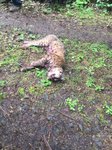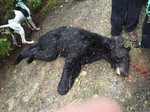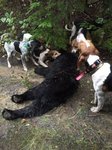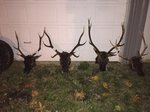



Game agent Brad Rhoden said the worst case of animal cruelty he’s ever seen comes from video footage of a bobcat hunt in Lewis County on Nov. 27, 2015.
In that footage, someone off camera fires at a treed juvenile bobcat as dogs bark below. Another person, Aaron Hanson, pushes the still-living cat off of a tree branch and onto the ground.
A pack of baying dogs swarm the downed bobcat, which feebly swipes back to defend itself before it is thrashed to death. Laughter can be heard throughout. Near the end of the video, a roughly 12-year-old child and family member briefly comes into frame.
“There was no doubt in my mind that that raised above and beyond any level of animal cruelty that I’ve ever seen,” Rhoden, a Department of Fish and Wildlife sergeant said. “It was extremely disturbing to watch that cat try to defend itself. And then to have the laughter, and the kids there? What type of person can do that?”
The video is just one piece of evidence in a sprawling WDFW case that investigated more than 100 poached animals, involved dozens of WDFW officers and convicted roughly one dozen suspects across several counties in Washington and Oregon.
The nine-month investigation and two years of court cases are now over, WDFW officials say, and WDFW Captain Jeff Wickersham said the case was the largest of its kind in state history. Officers came to simply call the poaching investigation “The Big Case,” Wickersham said.
“There was just a huge loss of life here,” Wickersham said. “It was hard to swallow that, when we really sat back and thought about what that really means.”
As much as he wishes it didn’t take such a high-profile series of killings, Wickersham said he believes the case has raised awareness that hunters and non-hunters alike should call in suspicious activity. Unlawful hunting remains a problem, he said, and smaller, isolated hunters are much harder to catch.
And WDFW spokesperson Becky Bennett said the public shouldn’t look at the sentences against the poachers — which include many one- or two-month stays in jail — as “a slap on the wrist.”
“We stopped them. They can’t do this again. Most of them had their hunting rights taken away. Several of them received felonies ... and they’re well known now in the court system.”
Six WDFW personnel, each hunters themselves, sat down with reporters last week to discuss their investigation and the end of the long court cases against the suspects. They repeatedly stressed that there was a distinction between ethical hunting and the actions of the poachers.
“Hunters are ethical,” Bennett said. “These are poachers. These are killers. They were doing it for sport ... Most hunters in the State of Washington are doing the right thing.”
Eddy Dills, formerly of Longview and now living in Idaho, was one of the hunters convicted in the case and has finished his jail time. He was handed a one month sentence in Skamania County and 60 days in Cowlitz County, along with $2,600 in fees. He was also convicted in Wasco County, where he has appealed, but he was acquitted of unlawful hunting charges in Clatsop County.
He recently told TDN that “there’s nothing brutal about” the way he hunted. He’s said WDFW lied to achieve their convictions. He admits he hunted with hounds, which was outlawed in Washington in 1996. But, as explored in an investigative series by King 5 news, he points out that the WDFW has been sued over allegedly allowing other hunters to kill and waste animals (A Thurston County judge ruled this year in favor of WDFW.)
“Yeah, we ran our dogs,” Dills said. “I’m not gonna deny that. We ran our hounds when we probably should not have. The lies that they told is, they were doing exactly the same thing behind the public’s back.”
The Investigation
WDFW officers and Oregon State Police had received reports of unlawful hound hunting in the vast, 1.3 million acre Gifford Pinchot National Forest for months before they could put names to crimes.
Trail cameras set up by OSP in late 2016 caught William Haynes and Erik Martin driving a Toyota pickup to a forested area south of The Dalles in the middle of a late November night. In the video, they return to their car carrying a deer head, and troopers found a headless deer carcass when they retrieved the cameras.
A few days later, OSP troopers pulled over Haynes and Martin after recognizing Hayne’s license plate from the video. The two confessed to killing two buck deer and a silver gray squirrel and allowed officers to search their cell phones — evidence from which kickstarted the broader investigation.
OSP met with Rhoden and Bahrenburg in Portland, then escorted the men back to Longview. Officers followed them back to their Longview residences to find the three animals, but they found far more that night: 26 deer heads or skulls in various states of decomposition, as well as a single elk head.
Cell phone information revealed connections to Joseph and Eddy Dills, who owned the hounds, and evidence of unlawful bear, cougar and bobcat hunting, WDFW officers said. Officers later learned of involvement from David McLeskey, who knew the Dills and owned his own dogs, and his son-in-law Aaron Hendricks.
“The story we got is, Joe purchased a dog from (McLeskey), and that’s how they met,” Officer Denis Budai said.
The officers said the Dills and McLesky turned out to be the nucleus of the group. The other poachers “needed the Dills” to provide the hounds in the first place, Sergeant Patrick Anderson said, and Eddy Dills was “the main push” to get his son Joe into hound hunting. Anderson said the Dills instructed some of the other poachers where and how to illegally hunt deer and elk.
Budai, Bahrenburg, Anderson and Rhoden make up the WDFW’s Cowlitz County detachment. They spent the better part of three months almost exclusively on investigating the “The Big Case” after the initial contact with Haynes and Martin.
“When we think about our already limited patrol capacity ... that was a big hit,” Wickersham said. “But this particular investigation warranted that.”
In that time, WDFW developed an audacious plan to search the main suspects in the case and their homes: Executing simultaneous search warrants at four different Cowlitz County residences (Haynes, Hendricks and both Dills), each with teams of about 10 Fish & Wildlife officers.
They needed the suspects all at home at the same time to search their cell phones without tipping the others off. So while they sent unmarked vehicles ahead to scout the houses, officers had another problem.
“Where do you secret 35 or 40 Fish & Wildlife officers in the community of Longview?” Wickersham asked rhetorically. “That was a third of our force. ... We brought staff in from all across the state.”
It took about two days of waiting before officers “pounced” on March 12, 2017, Wickersham said. They nearly missed Joe Dills, who was driving down the road from his home to get dog food as about 20 Fish & Wildlife trucks streamed up the other way.
Across the homes, officers seized deer, elk, a bear skull, a bobcat, pelts and meat. They also took vehicles, phones and firearms and interviewed some of the suspects in the case. Officers recovered troves of digital evidence that suspects attempted to hide, and Anderson said that some of the suspects acted “cocky” while handing over phones and other evidence.
The sheer volume of documentation of the poaches was unusual, Wickersham said: “They pretty much had all of the evidence. We just had to find it.”
“Virtually everything we got ... were deleted files,” Anderson said. “We had text messages that were deleted that said ‘Make sure you delete this.’ “
At this point, officers hadn’t yet filed charges. Doing so, Budai explained, would have “started the clock” on the criminal cases against them, and officers believed the case could still be larger than what they’d found.
Budai said that based on Hayne’s statements to police, only one bear hide, a claw and a couple of skulls were retained from about 28 bears WDFW was able to prove the group poached. Everything else was wasted.
Officers said that Haynes, who died in July 2019 according to a TDN obituary, was the most cooperative and apologetic core member of the poachers, and appeared to get wrapped in a group activity that grew out of control.
“He showed actual remorse for what had happened,” Anderson said. “In the end there’s a couple people that finally got to that point, but as far as March 12, there wasn’t another person who was cooperative. ... I think he was genuinely upset about what had happened.”
Poachers made mistakes even when they used an “old-school” JVC handheld camera to film their hunts and obfuscate dates and locations. (That’s where the bobcat video comes from.) Timestamps in footage from that camera, located at Hendrick’s residence, had been changed to throw off anyone who inspected it, officers said.
“But I have said this many times: A greater power loves game wardens,” Rhoden said. “Because in their (filming) of the hunt, they (accidentally show) their GPS. And so now we know there’s a GPS. And we know which road system they’re on. And we can guarantee it’s in the state of Washington ... That was our ‘aha’ moment.”
Officers used GPS data, text messages, location-tagged photos, social media posts, records from electronic dog collars and more to recreate precisely when, where, and which poachers were at each step of many of the illegal hunts. Armed with that data, they fanned out and found spots across Lewis, Jefferson, Skamania and other counties where bones, hair and other decomposing matter from killed animals still remained.
At one kill site, officers found a shotgun shell lodged in a bear skull, strands of bear fur sticking out of it. At another, Sgt. Anderson found a chunk of bear skull and a canine tooth sticking out of the ground.
“And I went, holy ----,” Anderson said. “I peeled it off the ground and realized it had come down the hill a little bit. You walk up ... and you’re like, oh my God, this is it. There was a bajillion other bones. The rest of the skull was there.”
In August 2017, WDFW officers began filing more than 200 charges against the Dills, Haynes, Martin and other suspects in the case. New charges would be filed throughout the year and into 2018. The last case was resolved in July, Wickerhsham said, when Eddy Dills received 60 days in jail at a sentencing at the Cowlitz County District Court.
But Dills, who now lives in Idaho with his family, says the ordeal is far from over. He says the investigation falsely smeared his family’s reputation, and that hound hunting has “never been understood.”
“It’s nothing brutal about it,” Dills said. “George Washington, our very first president, was the first houndsman. It’s one of the oldest style of hunting there is. ... I’m not saying we (didn’t have) bad apples in all the years. There are guys that can make it brutal if they want to make it brutal.”
In addition to fighting his Wasco County conviction, Dills is pursuing lawsuits against the WDFW and other organizations and prosecutors involved in the investigation.
“i’m gonna be honest,” Dills said. “They took my hunting license for life. (But) they didn’t take my hunting rights. That they will never take from me.”
Wickersham said the law is the law.
“The fact is, the citizens of our state decided that hound hunting was not OK,” Wickersham said.
And after years of search warrants, interviews and attending hearings in courtrooms, Wickersham said he’s proud of his team.
“We’re happy for what ended up happening,” Wickerhsam said. “At the end of the day, we would always like to see more ... It took a long time to get there, but we know that we did a good job with the case and the investigation. We had the outcomes we were hoping for, and for us, justice was served for these animals that were killed.”